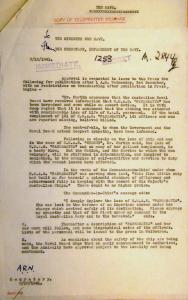Late November 1941 was a dark time for the Royal Australian Navy, with 2 major naval tragedies occurring within days of each other. The first is well known: the sinking of the HMAS Sydney by a German raider on 19 November with the loss of all 645 crew. Less well known is the sinking of the HMAS Parramatta just a few days later, with the loss of a further 138 lives.
From Sydney Harbour to the bottom of the Mediterranean
HMAS Parramatta was a Grimsby class sloop built at Sydney's Cockatoo Island Dockyard and launched in June 1939. During the Second World War, the Parramatta was deployed on patrolling, escort and minesweeping duties.
After participating in operations in the Red Sea, the Parramatta was assigned to the Mediterranean Station in 1941. There, it escorted convoys running vital supplies to the besieged Allied forces at Tobruk in Libya.
These were dangerous missions. After some near misses, in the early hours of 27 November 1941, the Parramatta was torpedoed and sunk by a German U-boat near Tobruk. Initially, 141 officers and crew were reported missing, feared dead. Prime Minister Curtin acknowledged the nation's compounded grief in his announcement: 'Following so closely on the loss of ship and men in the case of the H.M.A.S. "SYDNEY" … the loss of H.M.A.S. "PARRAMATTA" and so many of her gallant complement, is a heavy blow.'
A bitterly cold, dark and fateful night
Able Seaman Harold Moss remembered the night the Parramatta was sunk as bitterly cold and dark with clouds and rain. This forced most of the crew, who usually slept above decks, down below. Just after midnight, a single torpedo struck the side of the ship, followed by 2 explosions before the Parramatta immediately began to sink.
Only 2 people made it out from below deck. Harold was one: he had been sitting at the bottom of the companionway and was up the ladder and on deck within seconds. The other was Able Seaman George Stanley 'Alec' Ladhams. 'LIFEBELT ISSUED Parramatta' was stamped onto Alec's service card, but he had little chance to use it, having to escape quickly through a porthole wearing only his shorts.
Back from the dead
Harold Moss was fortunately one of 21 survivors who were rescued by the British ship HMS Avon Vale before it departed the scene, wary of further attack by German U-boats.
However, Alec Ladhams and 2 other survivors, William Frederick ('Fred') Tysoe and Albyn Miller, were not picked up by the Avon Vale and were initially counted among those feared dead.
Amazingly, after swimming in the sea for a couple of hours, the 3 men managed to clamber onto a drifting Carley life raft. They later came across a rowboat, which had seemingly been set adrift by other ships for any further survivors from the Parramatta. Ladhams, Tysoe and Miller made landfall on the Libyan coast between Tobruk and Bardia. Locals then risked their own lives to hide them from the Germans and Italians until Allied soldiers reached that part of Libya.
Back home, all that the families of Ladhams, Tysoe and Miller knew was that they were missing. As the weeks ticked by, their fears for the worst must have only grown. Then, out of the blue, came the news that they were alive. To the families, it seemed as if these 3 intrepid sailors had quite literally come 'back from the dead'!








![Pencil drawing: WRAN driver standing beside her utility vehicle [ute].](/sites/default/files/styles/feature_item/public/2020-04/th-feature-blog-rex-julius-9544589.jpg?h=8c713433&itok=PAahEwXK)
